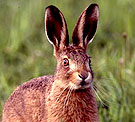Brown hare numbers rising after conservation efforts
Brown hares are increasing in number where farms are encouraged to provide their ideal habitat


Figures released today by WildCare, the farm wildlife habitat scheme, reveal brown hare numbers have increased by 35% on farms involved in schemes to encourage numbers of the animals back for good. The data, collated from two independent audits of each farm per year, involves detailed field measurements and recordings of sightings. WildCare assessors recorded sightings of 225 brown hares across Waitrose Select Farms, compared with 167 during the first round. The WildCare scheme works with the 60 farmers in the Waitrose Select Farm dairy pool, helping them enhance wildlife habitat on their farms. All maintain wide field margins in arable fields, where the grass is allowed to grow long and provide shelter for resting adults and for young. Delaying grass cutting is important as, although adult hares will run, leverets are at most danger at this time. The natural regeneration of wild plants in spring and early summer provides an ideal habitat and food sources.
Currently the farm with the biggest population is in Oxfordshire but farms in Wiltshire, Somerset, Dorset and Hampshire are also strongholds. Smaller populations are also evident on pool farms in Bedfordshire, Buckinghamshire, Gloucestershire and Stirlingshire.
Waitrose pays these farmers a premium for their milk in return for maintaining high standards of milk quality and farming in a manner which benefits wildlife. This extra cost is not passed on to the consumer.
How farmers are backing the brown hare’s corner:
*They break up large blocks of cereal crops with grassland areas * In arable fields, they keep wide field margins where the grass is allowed to grow long and provide shelter for resting adults and young. Some leave grassy strips within the field * In grassland, they provide areas where the grass is allowed to grow long in which leverets can hide *They leave stubble over winter to provide shelter * When making silage, they cut the field from the centre outwards to give hares the best chance of escaping to neighbouring fields
John Cousins, head of agricultural policy for The Wildlife Trusts, said: ‘WildCare is a beacon project and this news - that the brown hare is flourishing on these farms - is both encouraging and rewarding evidence farmers can make a difference. Dairy farming is a demanding industry which has experienced poor returns over the last few years.
'WildCare farmers are looking to help wildlife, such as the brown hare, through simple but highly effective measures. The participating farmers are aware their work is a vital support to The Wildlife Trusts’ efforts to further improve conditions for wildlife across the UK. Our vision for A Living Landscape is dependent on close working relationships with farmers; as they deliver many of the environmental benefits we seek, for people and wildlife.'
Sign up for the Country Life Newsletter
Exquisite houses, the beauty of Nature, and how to get the most from your life, straight to your inbox.
To comment on this article, use the comment box below, or email us at clonews@ipcmedia.com. Read more about the countryside.
Country Life is unlike any other magazine: the only glossy weekly on the newsstand and the only magazine that has been guest-edited by HRH The King not once, but twice. It is a celebration of modern rural life and all its diverse joys and pleasures — that was first published in Queen Victoria's Diamond Jubilee year. Our eclectic mixture of witty and informative content — from the most up-to-date property news and commentary and a coveted glimpse inside some of the UK's best houses and gardens, to gardening, the arts and interior design, written by experts in their field — still cannot be found in print or online, anywhere else.
-
 Two quick and easy seasonal asparagus recipes to try this Easter Weekend
Two quick and easy seasonal asparagus recipes to try this Easter WeekendAsparagus has royal roots — it was once a favourite of Madame de Pompadour.
By Melanie Johnson
-
 Sip tea and laugh at your neighbours in this seaside Norfolk home with a watchtower
Sip tea and laugh at your neighbours in this seaside Norfolk home with a watchtowerOn Cliff Hill in Gorleston, one home is taller than all the others. It could be yours.
By James Fisher